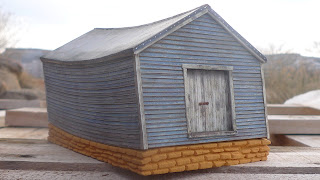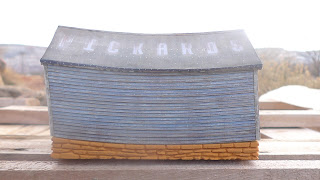The foundation is a small plane of wood drilled to accept the piles. This places the piles inboard of their position in the photo. I decided to deviate here, as I much prefer the strength of a positive connection. The floor and body are a slip fit, so, adding light is still an option. That the walls have a black core helps in that regard. While I am going to wait to do final scenery until I put this one on the layout, I am going to go ahead and make a diorama base for this one.
I also added a stove pipe soldered from three pieces of brass tube, as well as a foil ridge cap. The sienna paint from the ridge cap has been streaked down the roof. A little more under the stove pipe. I have slowly been adding paint to the boards to make them appear more varied and three dimensional. I am now on a quest for material to add the mesh below the floor.



















































